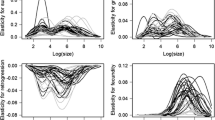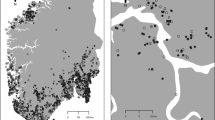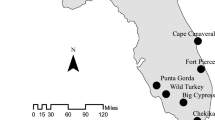Abstract
Understanding the factors that influence plant distributions is a considerable challenge for ecologists in the face of environmental change. Here, we quantify spatial and temporal variation in the finite rate of population increase of the annual grass Vulpia fasciculata. Specifically, we test the hypothesis that the northern range boundary is associated with finite rates of population increase of less than one. Seeds of three ecotypes of the annual grass V. fasciculata were introduced annually across a range of sites in Great Britain both within (11) and to the north (4) of its current range boundary in each of 4 years. Populations failed to establish at 17% of target sites due to disturbance. At the remaining target sites, the finite rate of population increase, λ, varied from 0.06 to 33.3 with a geometric mean of 1.88. Of the total variance in the rate of population growth, site and year effects accounted independently for 40% of the variation and in interaction for 50%; ecotype accounted for less than 5% of the variation. Variation in the weather between sites and years had little impact on plant performance, and there was no indication that the rate of population growth was lower to the north of the current range boundary. We conclude that current climatic conditions on the coast of Great Britain are not limiting the distribution of V. fasciculata and that seeds from across its current range have roughly equivalent colonising potential.



Similar content being viewed by others
References
Bullock JM, Hill BC, Silvertown J (1994) Demography of Cirsium vulgare in a grazing experiment. J Ecol 82:101–111
Chapin FS III, Chapin MC (1981) Ecotypic differentiation of growth processes in Carex aquatilis along longitudinal and local gradients. Ecology 62:1000–1009
Davis AJ, Jenkinson LS, Lawton JH, Shorrocks B, Wood S (1998) Making mistakes when predicting shifts in species range in response to global warming. Nature 391:783–786
Davy AJ, Smith H (1985) Population differentiation in the life history characteristics of salt marsh annuals. Vegetation 61:117–125
Davy AJ, Smith H (1988) Life-history variation and environment. In: Davy AJ, Hutchings MJ, Watkinson AR (eds) Plant population ecology. Blackwell, Oxford, pp 1–22
Fisher RA (1937) The wave of advance of advantageous genes. Ann Eugen 7:355–369
Freckleton RP (2000) Biological control as a learning process. Trends Ecol Evol 15:263–264
Freckleton RP, Watkinson AR (1998) Predicting the determinants of weed abundance: a model for the population dynamics of Chenopodium album in sugar beet. J Appl Ecol 35:904–920
Freckleton RP, Watkinson AR (2002) Are weed population dynamics chaotic? J Appl Ecol 39:699–707
Freckleton RP, Watkinson AR, Dowling PM, Leys AR (2000) Determinants of the abundance of invasive annual weeds: community structure and non-equilibrium dynamics. Proc R Soc Lond B 267:1153–1161
Freckleton RP, Matos DMS, Bovi MLA, Watkinson AR (2003) Predicting the impacts of harvesting using structured population models: the importance of density-dependence and timing of harvest for a tropical palm tree. J Appl Ecol 40:846–858
Hulme M et al (2002) Climate change scenarios for the United Kingdom: the UKCIP02 scientific report. Tyndall Centre for Climate Change Research, University of East Anglia, Norwich
Joshi J, Schmid B, Caldeira MC, Dimitrakopoulos PG, Good J, Harris R, Hector A, Huss-Danell K, Jumpponen A, Minns A, Mulder CPH, Pereira JS, Prinz A, Scherer-Lorenzen M, Siamantziouras ASD, Terry AC, Troumbis AY, Lawton JH (2001) Local adaptation enhances performance of common plant species. Ecol Lett 4:536–544
Kirby EJM, Porter JR, Day EW, Adam JS, Appleyard M, Ayling S, Baker CK, Belford RK, Biscoe PV, Chapman A, Fuller MP, Hampson J, Hay RKM, Matthews S, Thompson WJ, Weir AH, Willington VBA, Wood DW (1987) An analysis of primordium initiation in Avalon winter wheat crops with different sowing dates and at nine sites in England and Scotland. J Agric Sci Camb 109:123–134
Lennartsson T, Oostermeijer JGB (2001) Demographic variation and population viability in Gentianella campestris: effects of grassland management and environmental stochasticity. J Ecol 89:451–463
Levin DA, Clay K (1984) Dynamics of synthetic Phlox drumondii populations at the species margin. Am J Bot 71:1040–1050
Lintell-Smith G, Freckleton RP, Firbank LG, Watkinson AR (1999) The population dynamics of Anisantha sterilis in winter wheat, comparative demography and the role of management. J Appl Ecol 36:455–471
Mack RN, Pyke DA (1983) The demography of Bromus tectorum: variation in time and space. J Ecol 71:69–93
Menges ES (1990) Population viability analysis for an endangered plant. Conserv Biol 4:52–62
Nordbakken JF, Rydgren K, Okland RH (2004) Demography and population dynamics of Drosera anglica and D. rotundifolia. J Ecol 92:110–121
Porter JR, Kirby EJM, Day EW, Adam JS, Appleyard M, Ayling S, Baker CK, Beale P, Belford RK, Biscoe PV, Chapman A, Fuller MP, Hampson J, Hay RKM, Hough MN, Matthews S, Thompson WJ, Weir AH, Willington VBA, Wood DW (1987) An analysis of morphological development stages in Avalon winter wheat crops with different sowing dates and at ten sites in England and Scotland. J Agric Sci Camb 109:107–121
Preston CD, Pearman DA, Dines TD (2002) New atlas of the British and Irish flora. Oxford University Press, Oxford
Prince SD, Carter RN (1985) The geographical distribution of prickly lettuce (Latuca serriola) III. Its performance in transplant sites beyond its distribution limits in Britain. J Ecol 73:49–64
Sawada S, Nakajima Y, Tsukada M, Sasaki K, Hazama Y, Futatsuya M, Watanabe A (1994) Ecotypic differentiation of dry matter processes in relation to the survivorship and reproductive potential in Plantago asiatica populations along climatic gradients. Funct Ecol 8:400–409
Schmidt KP, Levin DA (1985) The comparative demography of reciprocally sown populations of Phlox drummondii Hook. I. Survivorships, fecundities and finite rates of increase. Evolution 39:396–404
Silvertown J, Franco M, Pisanty I, Medoza A (1993) Comparative plant demography—relative importance of life-cycle components to the finite rate of population increase in woody and herbaceous perennials. J Ecol 83:465–476
Skellam JG (1951) Random dispersal in theoretical populations. Biometrika 38:196–218
Soil Survey (1982) Soil Survey of Scotland
Soil Survey (1983) Soil Survey Map of England and Wales. Soil Survey, Harpenden
Stokes KE, Allchin AE, Bullock JM, Watkinson AR (2004) Population responses of Ulex shrubs to fire in a lowland heath community. J Veg Sci 15:505–514
Turnbull LA, Crawley MJ, Rees M (2000) Are plant populations seed-limited? A review of seed sowing experiments. Oikos 88:22538
Valverde T, Silvertown J (1998) Variation in the demography of a woodland understorey herb (Primula vulgaris) along the forest regeneration cycle: projection matrix analysis. J Ecol 86: 545–562
Watkinson AR (1978) Biological flora of the British Isles—Vulpia fasciculata. J Ecol 66:1033–1049
Watkinson AR (1985) On the abundance of plants along an environmental gradient. J Ecol 73:569–578
Watkinson AR (1990) The population dynamics of Vulpia fasciculata: a nine year study. J Ecol 78:196–209
Watkinson AR, Freckleton RP, Forrester L (2000) Population dynamics of Vulpia ciliata: regional, patch and local dynamics. J Ecol 88:1012–1029
Watkinson AR, Gill JA, Freckleton RP (2003) Macroecology and microecology: linking large-scale patterns of abundance to population processes. In: Blackburn TM, Gaston KJ (eds) Macroecology: concepts and consequences. Blackwell, Oxford, pp 256–273
Williamson M (1996) Biological invasions. Chapman & Hall, London
Woodward FI, Jones N (1984) Growth studies of selected plant species with well defined European distributions. 1. Field observations and computer simulations in plant life cycles at two altitudes. J Ecol 72:1019–1032
Acknowledgements
We acknowledge the financial support provided by NERC through its TIGER (Terrestrial Initiative in Global Environmental Research) programme 4.2a, award numbers T03087b6 (LGF) and GST/02/639 (ARW). We also acknowledge the co-operation of the English Nature, Scottish Natural Heritage, Countryside Council for Wales, Llanelli Borough Council and the MOD for permission to carry out the research. This paper is dedicated to Roger Gilby who helped to make the fieldwork possible and enjoyable.
Author information
Authors and Affiliations
Corresponding author
Additional information
Communicated by Christian Koerner
Rights and permissions
About this article
Cite this article
Norton, L.R., Firbank, L.G., Scott, A. et al. Characterising spatial and temporal variation in the finite rate of population increase across the northern range boundary of the annual grass Vulpia fasciculata . Oecologia 144, 407–415 (2005). https://doi.org/10.1007/s00442-005-0102-8
Received:
Accepted:
Published:
Issue Date:
DOI: https://doi.org/10.1007/s00442-005-0102-8




